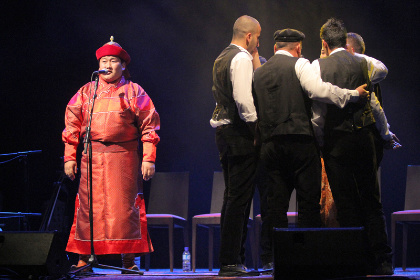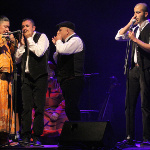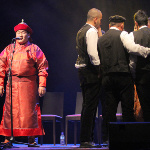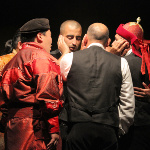- country:Italy
- region:Mongolia
- style(s):A Cappella, Ethnic
- label:not signed
- type:Small Ensemble
- gender:male
- instrumentation:instrumental, a cappella
- artist posted by:Marsab Music Management
Line up
- Garzoring Nergui (chant khoomij, liuto tovshuur, viella morin-khuur)
- Gian Nicola Appeddu ( contra)
- Mario Siotto (bassu, trunfa)
- Massimo Roych (voche, trunfa, flute pipiolu)
- Piero Pala (mesuvoche)
- Tonino Carta (voche)
- Tsogtgerel Tserendavaa (chant khoomij, flute tsuur, viella morin-khuur)
THE SONGS OF SARDINIAN TENORES MEETS THE DIPHONIC MONGOLIAN CHANT
CUNCORDU E TENORE DE OROSEI AND MONGOLIAN SINGERS TS. TSOGTGEREL ET N. GANZORING
In the heart of countryside still considered sacred, the harsh beauty of the Sardinian mountains meets the vast steppes through the polyphony of the Tenores and Khoomii overtone chants.
Within the confines of the sacred and the profane, somewhere between liturgy and peasant celebrations, these voices resonate in the heights of Sardinian mountains.
It is there that the beauty of a pastoral culture is still to be found. The Sardinian polyphonies date back to the Nuragic age when these nuraghi or round towers were built, in the form of truncated cones. These megalithic edifices remain the symbol of this age between 1900 and 730 years BCE (between the bronze and iron ages).
Beyond these towards other mountains equally sacred since prehistoric times, those of the Gobi-Altai steppes, where the Altai mountains meet the immense Gobi desert,
legend has it that overtone chant was born. Here it is known as Khoomii, meaning larynx. It is accompanied by the morin-khuur or khiil-khuur, the horse head fiddle of the poet and sootsayer. Overtone chant is a musical metaphor for this land: the hilltops and the valleys, the vastness of the steppes, the herds, the tumult of nature, its rumbles and its murmurs, the galloping horses and the rustling of its wind grasses.
Surprisingly, in the heart of these two traditions, we find the instrument known as the guimbarde or Jew's harp, an instrument familiar to nomadic shepherds all over the world.
This original work highlights the richness of these vocal techniques of people who belong to the same history of mankind and who are the last witnesses of ancient times when man knew how to be one with nature.





